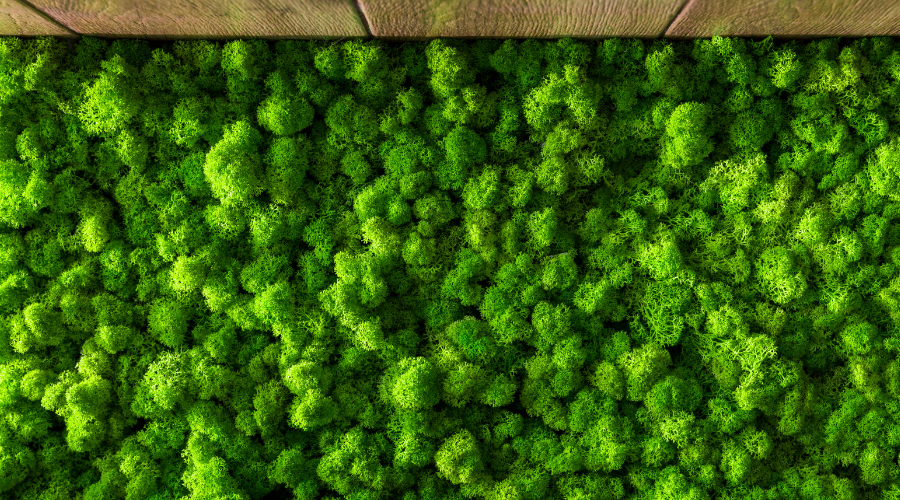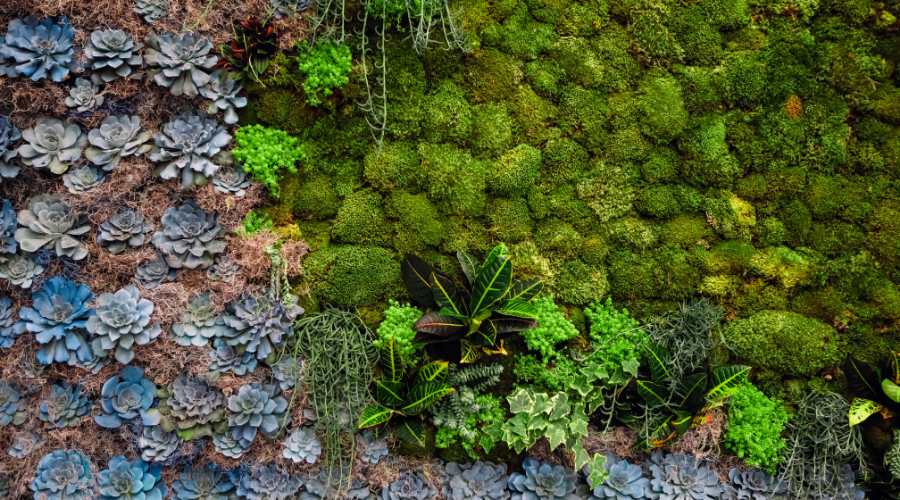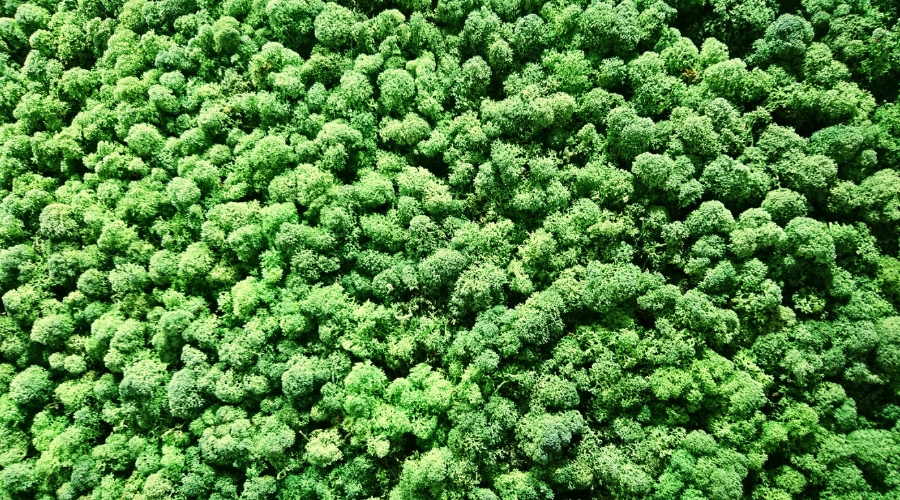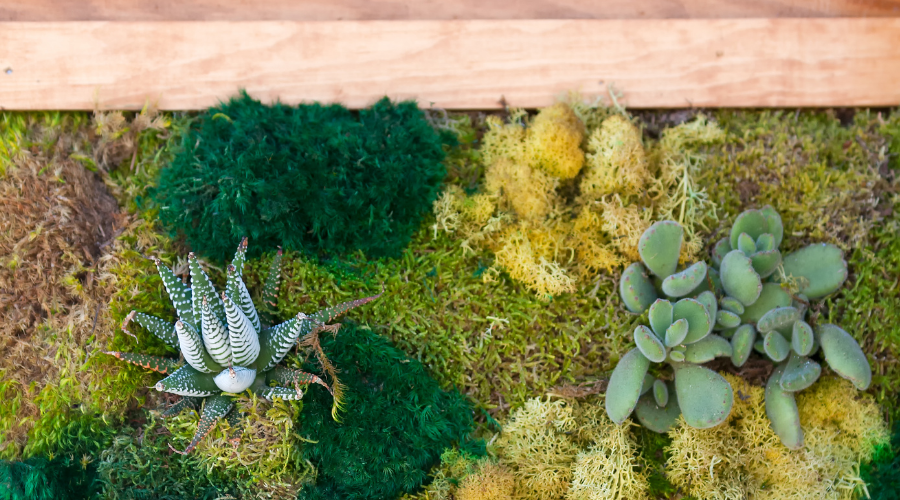As people strive to bring more nature into their homes, moss wall ideas have become a trend we’re seeing more of these days. The soft, greenery is reminiscent of a deep forest and brings a sense of calm serenity into your home.
Artificial moss is made from plastics and polyesters, so we don’t recommend it for the best effect. Luckily you have options when it comes to natural moss walls in your home. In this post, we’ll compare two of the most popular options; living moss walls vs preserved moss walls.
Living Moss Wall
Image credits: P_Wei via Canva
Nothing can replace the real thing. But before you go out and start designing your living moss wall, there are a few things you should know first.
It's the real thing!
First of all, as the name implies, this is a living organism. And like any living organism, it’s going to require some upkeep to stay alive.
A living moss wall needs water to survive. Like any houseplant, a living moss wall is going to require consistent watering to keep it alive. Some systems come with a whole hydroponic watering system built in. While this system still requires some maintenance, it’s going to require a lot less maintenance than a system you may have built yourself.
Even with a hydroponic system, you should still mist the living moss wall regularly. Moss thrives in damp, moist environments, like the forest floor. So you’re going to have to emulate these conditions as closely as possible.
It needs nutrients
The next thing to remember is that moss needs certain nutrients to survive as well. Water is essential to life, but it’s not the only thing that moss needs to stay alive.
The beauty of hydroponic setups is that you can add nutrients to the water in the system. This means that watering and feeding your moss wall will be completely integrated into one system, cutting down on maintenance time.
All this water, nutrients, and moss have to exist in a substrate. In its natural environment, moss will thrive on a substrate of forest soil or old, rotting wood. You don’t have to have decomposing trees inside your home to have a living moss wall, but you will need some sort of substrate to hold onto all of that material. The kind of substrate you choose will depend on your installer and the system that you go with.
There are risks
A living moss wall comes with a few more challenges besides maintenance. Running water always poses the risk of a leak. And I don’t think I need to explain to you why a leak inside your home isn’t a good thing.
A living moss wall is also heavy. This means you have to consider where you want to install a living moss wall and whether the structure can handle the extra weight. This will naturally be a limiting factor to where you can install a living moss wall.
Another limiting factor for placement is access to light. Although moss thrives in low-light situations, it still needs light to survive. If your living moss wall doesn’t have access to enough natural light you’ll have to install grow lights.
All this to say, a living moss wall is a more or less permanent structure. There’s a lot that goes into having a living moss wall inside your home so make sure you choose the location carefully before you commit.
- Living organism
- Sound of flowing water
- Most realistic
- High maintenance
- Heavy
- Permanent
|
|
Preserved Moss Wall
Image credits: hamikus via Canva
A preserved moss wall is natural moss that has been preserved in its natural state. It's like the best moss wall art, but on a much larger scale.
Preservatives
Preserved moss walls come in many different forms, with a huge selection of moss species and every type of preservative under the sun.
Since your preserved moss wall is going to be inside your house I would recommend paying close attention to what types of preservatives are being used. Preservatives are notoriously harmful to your health, not only in food but in any other setting as well. Building material preservatives can off gas into your home years after installation.
That being said, there are many natural preservatives out there that will not cause you any harm. They do a great job of preserving moss and may even retain a more natural look to the moss for a longer period of time.
My advice would be to not compromise on making sure you have a natural preservative in your preserved moss wall.
Maintenance
When it comes to maintenance, preserved moss walls are really easy. In fact, once the wall is installed, there’s little to no maintenance required. That means no watering, no feeding, and no light is required.
You may have to dust it regularly if you live in a dusty area but that’s about it.
Lightweight
A preserved moss wall is quite a light wall system because there’s no substrate or water in the system adding all its weight. This means that you can install a preserved moss wall in many places where you couldn’t install a living moss wall. You won’t have to make extra considerations for an extra heavy wall somewhere in your home.
This also means that a preserved moss wall doesn’t have to be a permanent structure in your home. In a few years time, you might be ready for a new look. If so, you’ll be able to easily remove the wall and replace it with something else.
- Low to no maintenance
- Light
- Easy to install
- May lose realistic look
- Preservatives may be toxic
|
|
Which One To Choose
Image credits: PamelaJoeMcFarlane via Canva
Living moss walls are impressive. The fact there’s a whole living ecosystem right there on your wall is impressive indeed. The wall could also be designed so that you can hear the flow of water for maximum biophilic effect.
That being said, you have to make sure you’re prepared for the maintenance and upkeep. On top of that, this is a heavy structure that means plenty of support and is most likely to be there for a long time.
So if you have a spot that you’d permanently like to have a moss wall, and you’re prepared for the upkeep, then a living moss wall is the choice for you.
On the other hand, if you like the trend of moss walls inside homes, but you don’t think you want one permanently, consider a preserved moss wall.
You can still get the look and feel of having a moss wall in your home without the commitment of maintaining a large, heavy living organism inside your home. Preserved moss walls are also a great choice for spaces that don’t get much natural light and you don’t want to install grow lights.
What Will You Choose?
Now that you know all there is to know about living and preserved moss walls, as well as the specific differences between the two, which one will you choose? Comment below and let us know which choice you make.




